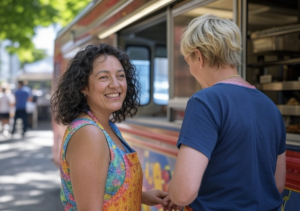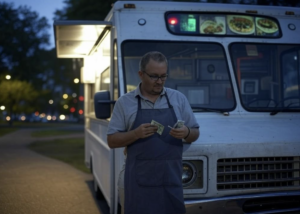Hey folks, Richard Willis here from M&R Specialty Trailers and Trucks. After building food trucks for over two decades, I’ve seen this industry transform from simple lunch wagons to high-tech culinary powerhouses. And let me tell you, 2025 is shaping up to be one wild ride.
The Numbers Don’t Lie
The food truck industry hit $2.4 billion in revenue this year, with over 58,000 trucks rolling across America. That’s a 15.9% jump in businesses since 2019. And here’s the kicker – we’re expecting to reach $8.78 billion globally by 2033. Not bad for an industry that started with ice cream trucks and taco stands.
I remember when having 10 food trucks in a city was a big deal. Now, California alone has over 750 operations. My buddy in LA tells me you can’t throw a stone without hitting a gourmet food truck these days. The growth isn’t just in numbers – it’s in sophistication. Today’s food truck owners are pulling in anywhere from $250,000 to $500,000 annually, with some top performers breaking into seven figures. Compare that to the average startup cost of $70,000 for a used truck, and you can see why entrepreneurs are jumping into this business.
Tech Takes the Wheel
Remember when taking orders meant shouting through a window? Those days are gone. Today’s trucks are rolling with QR code menus, AI-powered ordering systems, and GPS tracking that lets customers hunt you down.
Last week, I installed a full cloud-based POS system in a truck heading to Austin. The owner can track inventory, process payments, and even predict which items will sell out all from their phone. One truck in Singapore, Ono Food Co., went full sci-fi with robots handling everything from cooking to payment.
The real game-changer? Text message marketing and mobile apps. Trucks are building loyal followings by sending out location updates and daily specials right to customers’ phones. Smart cookies, these new operators. Some trucks are even using geofencing technology to automatically alert nearby customers when they’re setting up shop. It’s like having a digital town crier announcing your arrival.

Outside a food truck.
Green is the New Black
Sustainability isn’t just a buzzword anymore. It’s becoming standard operating procedure. I’m retrofitting more trucks with solar panels than ever before. One operator in Seattle powers their entire operation with solar and even filters their own water. Their tagline? “Zero waste, maximum taste.”
Compostable packaging is huge now. Remember those styrofoam containers? Ancient history. Today’s trucks use plant-based boxes that decompose faster than last week’s leftovers. The Goodburger Food Truck in Singapore takes it further – they’ve eliminated single-use plastics entirely and source ingredients locally to reduce their carbon footprint.
Electric and hybrid trucks are rolling out too, though the price tag still makes some operators sweat. But here’s the thing – customers are willing to pay a premium for eco-friendly options. One truck owner told me their sales jumped 15% after going green. Turns out, saving the planet is good for business.
Fusion Fever
Korean-Mexican fusion started with Kogi BBQ in LA back in 2008, and it’s still going strong. But now we’re seeing wild combinations everywhere. Filipino-Southern BBQ? Check. Indian-Italian? You bet. Japanese-Cajun? Why not!
I built a truck last year for Korea Taqueria in Philly. The owners blend their Korean and Mexican heritage into dishes like kimchi cheese fries and bulgogi cheesesteaks. Their Korean birria tacos have people lining up around the block. These fusion concepts aren’t just gimmicks – they’re creating entirely new flavor profiles that traditional restaurants can’t touch.
The beauty of fusion in food trucks is the low risk, high reward nature. A restaurant committing to Korean-Mexican fusion is a big gamble. A food truck? They can test the waters, refine the menu, and build a following before making bigger moves. Many successful fusion trucks have gone on to open brick-and-mortar locations once they’ve proven the concept.

Fusion food truck menus are on the rise.
The Robot Revolution
Automation is creeping into our trucks faster than a lunch rush line. Automated fryers that know exactly when your fries are perfect. Prep robots that can dice onions without shedding a tear. Even AI systems that predict what customers will order based on weather, time, and past preferences.
One operator in Houston told me their automated cooking system reduced their prep time by 40%. That means faster service, consistent quality, and fewer burned batches when things get hectic. The manufacturing industry is seeing similar trends, with automation creating new job opportunities rather than replacing workers entirely.
The key is finding the right balance. Full automation like robot-run trucks might work in tech hubs, but most customers still want that human touch. The sweet spot is using automation to handle the repetitive tasks while your team focuses on customer service and food quality.
Themed Experiences
Food trucks aren’t just about food anymore. They’re entertainment on wheels. I recently wrapped a truck to look like a 1980s arcade, complete with neon lights and retro game sounds. Another client wanted a “tropical paradise” theme with fake palm trees and beach music.
These themed trucks charge premium prices because they’re selling an experience, not just a meal. Smart move in a market where everyone’s fighting for attention. The Instagram factor is huge here… people still love sharing photos of unique trucks.
Some trucks are taking it even further with pop-up collaborations, partnering with local breweries, musicians, or artists to create mini-festivals wherever they park. It’s about creating a destination, not just being another lunch option.
Virtual Kitchens and Ghost Trucks
Here’s a trend that’s picking up steam. Virtual food trucks that exist mainly online. They park in commissary kitchens and fulfill delivery orders through apps. No street parking hassles, no weather worries, just pure kitchen efficiency.
One operator runs three different “brands” from the same truck, switching menus based on delivery app algorithms. Monday they’re a burger joint, Tuesday they’re serving Thai, Wednesday it’s pizza. Wild times. These ghost kitchens are particularly popular in cities with tough regulations or limited parking. Why fight for a prime lunch spot when you can run five virtual restaurants from one kitchen?
The challenge is building brand loyalty without face-to-face interaction. Smart operators are using social media, loyalty programs, and killer packaging to create connections with customers they never actually meet.
Location, Location, Innovation
Forget fighting for the same old spots. Today’s successful trucks are creating their own destinations. Food truck parks are popping up everywhere, complete with seating, live music, and craft beer gardens. It’s like a permanent food festival.
Business districts remain gold mines during lunch hours, but the real money’s in catering. Corporate events, weddings, private parties – that’s where trucks are making bank. One operator told me catering accounts for 70% of their revenue. The beauty of catering is predictability – you know exactly how much food to prep, where you’ll be, and what you’ll make.
Some cities are also loosening regulations, creating more opportunities. Portland, Austin, and LA lead the way in food truck-friendly policies. Even traditionally tough markets like Boston are starting to come around as they see the economic benefits these mobile businesses bring.
Data-Driven Decisions
Today’s successful trucks run on data as much as diesel. Modern POS systems track everything – bestsellers, peak hours, customer preferences, even weather patterns. This data helps operators make smarter decisions about everything from menu changes to parking locations.
Dynamic pricing is starting to catch on too. Slow Tuesday afternoon? Push a notification with a 15% discount. Slammed on Friday night? Prices adjust automatically to manage demand. It’s like Uber surge pricing, but for tacos.
The trucks using data effectively are seeing 20-30% revenue increases just from optimizing their operations. It’s not sexy, but knowing that you sell 40% more burritos on cloudy days can make the difference between profit and loss.
What’s Next?
After decades in this business, I’ve learned to expect the unexpected. But here’s what I’m betting on:
More International Cuisines: Eastern European food is having a moment. I’m designing trucks for pierogi, borscht, and schnitzel concepts. Authentic ethnic food from first-generation immigrants always wins. We’re also seeing interest in African cuisines – Ethiopian, Nigerian, Moroccan. The more diverse our communities become, the more diverse our food truck offerings.
Hyper-Local Sourcing: Trucks partnering with specific farms, featuring daily menus based on what’s fresh. One truck in Portland changes their entire menu every three days based on farmer’s market finds. It’s farm-to-table on wheels, and customers eat it up (literally).
Dessert Domination: Sweet trucks are multiplying faster than savory ones. Artisanal ice cream, gourmet donuts, Japanese cheesecakes – if it’s Instagram-worthy and sugar-filled, it’s trending. The profit margins on desserts are insane too. That $8 artisanal donut costs maybe $1.50 to make.
Subscription Services: Monthly meal plans from food trucks. Pay upfront, get exclusive access to locations and menu items. It’s working for some operators in tech-heavy cities. Think of it as CSA boxes, but for street food.
Health-Tech Integration: Trucks partnering with fitness apps, offering meals that sync with your health goals. Scan your app, get a meal tailored to your macros. It sounds crazy, but I’m already getting inquiries about installing the tech for this.
The Bottom Line
This industry has come a long way from when I built my first truck back in the day. Today’s food truck owners are tech-savvy entrepreneurs serving restaurant-quality food with the flexibility to pivot faster than any brick-and-mortar joint.
Sure, 60% of trucks still fail within three years – same as restaurants. But the ones who make it? They’re pulling in $250,000 to $500,000 annually, with top performers hitting seven figures. Not bad for a “trend” that was supposed to die out years ago.
The food truck revolution isn’t slowing down. It’s shifting gears and accelerating. Whether you’re thinking about starting a truck or just love hunting down the best eats on wheels, one thing’s certain – the best is yet to come.
For those considering jumping into the food truck game, my advice is simple: start with a solid concept, invest in quality equipment, embrace technology, and never compromise on food quality. The barriers to entry are lower than ever, but the bar for success keeps rising. That’s not a bad thing – it means the cream rises to the top. Keep rolling, folks. And if you need a truck built, you know where to find me.

Leave A Comment